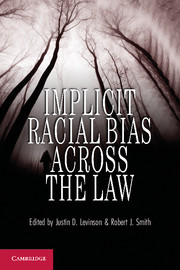Book contents
- Frontmatter
- Contents
- Contributors
- Acknowledgments
- Implicit Racial Bias Across the Law
- Introduction Racial Disparities, Social Science, and the Legal System
- 1 Implicit Racial Bias
- 2 Property Law
- 3 Criminal Law
- 4 Torts
- 5 Employment Law
- 6 Health Law
- 7 Education Law
- 8 Communications Law
- 9 Corporations Law
- 10 Tax Law
- 11 Intellectual Property
- 12 Environmental Law
- 13 Federal Indian Law
- 14 Capital Punishment
- 15 Reparations Law
- Index
- References
3 - Criminal Law
Coloring Punishment: Implicit Social Cognition and Criminal Justice
Published online by Cambridge University Press: 05 June 2012
- Frontmatter
- Contents
- Contributors
- Acknowledgments
- Implicit Racial Bias Across the Law
- Introduction Racial Disparities, Social Science, and the Legal System
- 1 Implicit Racial Bias
- 2 Property Law
- 3 Criminal Law
- 4 Torts
- 5 Employment Law
- 6 Health Law
- 7 Education Law
- 8 Communications Law
- 9 Corporations Law
- 10 Tax Law
- 11 Intellectual Property
- 12 Environmental Law
- 13 Federal Indian Law
- 14 Capital Punishment
- 15 Reparations Law
- Index
- References
Summary
The United States has become the world's leader in incarceration. The size and pervasiveness of the criminal justice regime have no parallel in history. One in 100 citizens are locked away in prisons and jails – a figure that reflects a tenfold expansion in the corrections population in less than four decades. If we count those individuals who are currently on probation or parole, more than 7 million men and women are under legal supervision – a number equal to the population of Israel. This system of mass incarceration – which includes policing, corrections, and the courts – employs 2.2 million Americans – which exceeds the 1.7 million Americans employed in higher education and the 650,000 employed by the system of public welfare. At the turn of the millennium, approximately 1.5 million children had at least one parent in jail or prison, and 10 million have had a parent in jail at some time during their lives.
Racial disparities are a defining feature of this regime. One in eight black males between the ages of 20–29 are in prison or jail on any given day, as compared with 1 in 59 white males of the same age. At the beginning of the new millennium black males had almost a 1 in 3 chance of serving time in prison, as compared with 3 in 50 for white males. The Leadership Conference on Civil Rights has suggested that current criminal justice policies and practices “threaten to render irrelevant fifty years of hard-fought civil rights progress.”
- Type
- Chapter
- Information
- Implicit Racial Bias across the Law , pp. 45 - 60Publisher: Cambridge University PressPrint publication year: 2012
References
- 4
- Cited by

